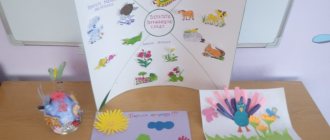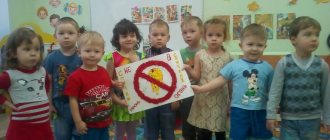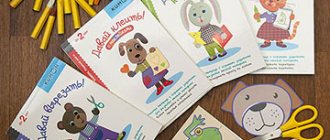Junior group. Early childhood, nursery. Children 1-4 years old
Dramatization game for children 3 years old “Kolobok and the road” Dramatization for children 3 years old “Kolobok and the road”
Goal: Continue to introduce children to the rules of the road in a playful way, using the theatrical performance
“Kolobok”
. Develop safe behavior skills on the road. Continue to familiarize yourself with traffic lights. Attract...
Summary of the game-dramatization based on the Russian folk tale "Kolobok" (second junior group) Purpose: 1. Lead children to play activities, dramatization of the Russian folk tale "Kolobok". 2. Learn to portray the heroes of a fairy tale using voice, facial expressions, and gestures. 3. Activate children’s speech expressions, monitor the intonation expressiveness of children’s speech during...
Dramatization of the Russian folk tale “Teremok” in the 2nd junior group
Dramatization of the fairy tale “Teremok” in the second junior group “Sun”
Goal: Formation of children’s creative abilities. Objectives: 1.Teach students to improvise simple movements, imitation movements and singing skills; 2. Create an emotional mood in students to receive joy and satisfaction from participating in a fairy tale; 3. Foster a desire to help those who need help. Equipment: house-teremok, box with riddles and toys with answers, scenery, clearing, costumes for dramatizing fairy tales for children, costumes for presenters, musical arrangement, light music, poster, invitation cards. Characters: Presenter -1 Svetlana Viktorovna.
Presenter -2 Faina Kabdullaevna. Mouse - Dasha Volkova. Frog-Ulyana Apanasenko. Bunny – Maxim Bogdan. Fox - Dasha Strakhova. Wolf - Ignat Tsigir. Bear - Milana Pernitskaya. Progress of the lesson.
In the center of the group there is a house-teremok, a forest clearing is decorated, and chairs are prepared for children and guests in front of the house.
Children enter the group to the soundtrack “Visiting a Fairy Tale.” (music sounds low). They stand in a semicircle and greet guests in Kazakh and Russian. The presenter comes out and greets everyone. Presenter : Hello, my dear children, girls and boys, and you, dear guests, hello! you came to us today, we are always glad to have guests. Attention attention! Residents and guests of a fairy-tale, kindergarten, mysterious, cheerful, talkative, funny and happy state. In our wonderful kindergarten, the lesson will be interesting. Fairy tales are loved by everyone in the world, adults and children love them, they teach us how to live so that everyone around us can be friends. We will go to visit the fairy tale at this hour now. Today we will visit a fairy tale. ...and which one you will find out from after completing our task.. The presenter holds a box inside which contains toys based on the fairy tale “Teremok” Presenter: Children, we walked along the path and found a beautiful box. And the box is not simple, it’s magical, that’s how it is! Presenter: what a beautiful box, I wonder what’s in it? (he tries to open it, but it doesn’t open - Maybe a fairy tale? The fairy tale is hidden in a riddle. Well, try and guess. If the answer is correct, the fairy tale will come to us again! The presenter begins to make riddles and the box opens to the music.
1. A small ball fumbles under the bench . (mouse) (the box opens and he takes out a toy mouse.) 2. In the summer in the swamp you will find it. Green frog, who is it - (frog) 3. Rushes without looking back, only his heels sparkle. Quickly guess who this is a (bunny). 4. A cunning cheat, a red head. A fluffy tail - a beauty! What is her name? (a fox) 5. In the winter she sleeps - in the summer she stirs up hives (a bear).
Presenter : Well done guys, you guessed all the riddles, that’s how many toys were given to us by a magic box! Presenter : Children, be quiet, don’t make noise, don’t scare away our fairy tale, there are miracles here... The fairy tale is hidden for now! Don’t be sad, smile, the fairy tale gives you a surprise. Presenter : touches the toys with a magic wand and says: Fairy tale , fairy tale, come and bring the toys to life! Where are you, fairy tale, show yourself and answer the guys! (children close their eyes at this time children dressed in costumes appear). Presenter : The children were really looking forward to the fairy tale, the fairy tale is already friends here, the fairy tale has come here again. What is it called? Children: Teremok.. Presenter: The sun is shining, the fairy tale begins. We all know, we all believe, There is a wonderful tower in the world. Tower, tower, show yourself, show yourself, stop. Towards the forest with the garden facing us. And a window and a porch. Educator : Here comes Teremok, let's sit back and see what happens next. The red summer has flown by, the days have come rainy, no, damp in the rain. But the dry, excellent house, it’s true, the word is not bad, but it still stands empty, it really needs an owner, look... someone is splashing through the puddles... Educator: There is a mansion in the field, a mansion It’s not low, it’s not high, it’s not high . There's a mouse running across the field. She stopped at the door and knocked. Mouse: I knock on the door, I knock, I want to get into the little house. But the owners are silent. They don’t want to open it for me. I’m on the right, I’m on the left. I looked around the little house, the door was open, there was silence, I will live here alone. Educator: The mouse began to live in the mansion alone. There is a teremok in a field, a teremok It is not low, not high, not high. Educator : Here is a frog running across the field. Frog: Kva-kva-kva-kva. Educator : She stopped at the door and knocked. Frog: I'm knocking on the door, I'm knocking, I want to get into the little house, Who lives in the little house, Who lives in the low house? Mouse: I’m a little mouse, and who are you? Frog: And I'm a frog. Mouse: What can you do? Frog: I can read nursery rhymes. The frog reads the nursery rhyme “Cucumber, cucumber, don’t go to that end, the mouse lives there and will bite off your tail.” Mouse: Come in! Educator: The two of them began to live together, the mouse bakes pies, and the frog goes for water. Educator : There is a tower in the field, the tower is not low, not high, not high. Here a bunny runs across the field, stops at the door and knocks. Bunny: I knock on the door, knock, I want to get into the little house. Animals: Who is knocking on our door again? Bunny: I am a runaway bunny, Oh, let the bunny in and feed him lunch! Animals: What can you do? Bunny: I love to play. Let's play the round dance game “The little white bunny is sitting.” Educator : Well done, we played well. Animals: Come in, bunny, you will live with us. Educator : The three of them began to live together. The mouse bakes pies, the frog walks on water, and the bunny sings songs. Educator: There is a mansion in the field, a mansion, It is not low, not high, not high. Here is a little fox running across a field. Fox: - I am a fox, I am a little sister. I walk quietly. Early in the morning, out of habit, I went out hunting. Teacher: The Fox stopped at the door and knocked: I knock on the door, I knock, I want to get into the little house. Animals: Who's there? Fox: It’s me, little fox-sister. Will you let me into the little house? Animals: What can you do? Fox : Make riddles. 1.Lives in a hollow and gnaws nuts. 2.White in winter and gray in summer. 3. Fluffy tail, golden fur Lives in the forest, steals chickens in the village. Animals: Come in. Educator: The four of them began to live together. There is a mansion in the field, a mansion, It is not low, not high, not high. Here a top runs across the field, stops at the door and knocks. Wolf: I knock on the door, I knock, I want to get into the little mansion. Don't be afraid of me in our fairy tale miracles! I won’t eat anyone here, I’ll smile at everyone! Animals: What can you do? Wolf: I can sing a song. “Shadow, shadow, shadow,” and the guys will help me. (They sing a song shadow-shadow-shadow, the animals sat down under the fence, the bunny lolled around, come and catch up, the fox boasted - I am beautiful to the whole world, the bear boasted that I can sing songs, the hedgehogs boasted - our fur coats are good.) ... Animals: Come in. Educator: The five of them began to live. There is a mansion in the field, a mansion, It is not low, not high, not high. Here is a bear walking across the field, stopping at the door and knocking. Bear: I knock on the door, I knock, I want to get into the little house. Well, open up the animals and let me into the little house. Animals: What can you do? Bear: I am a bear, I am a bear, I can sing songs. Uh-uh-uh. Educator and animals : Teddy bear, little bear, You don’t know how to sing songs. Bear: I have been a bear for a long time, a wonderful dancer. Top, top, top. Teacher and animals: You are confused again, you don’t know how to dance. Educator : Animals, let's teach the bear to sing and dance. Dance “A bear and a doll are briskly stomping”
Bear: Well, thank you animals for teaching me to sing and dance.
For this I will treat you, help yourself. (Hands out treats) All the animals to the children : Children, have plenty of rest, quickly, quickly everyone get up, we invite all the people to a fun round dance!!!! (children dance to cheerful music) Presenter: The guys have been artists! And the guys showed us a fairy tale! The artists and spectators were all good!!!! Let's clap for each other from the bottom of our hearts!! Host: Dear guests and guys, thank you all very much for your attention.
We recommend watching:
Theatrical activities in kindergarten Theater in the second junior group Do-it-yourself hat. Master class with step-by-step photos Script of a theatrical performance for children with disabilities (CP)
Similar articles:
Dramatization of Chukovsky's fairy tale The Fly Tsokotukha for children 5-7 years old
Dramatization of a fairy tale in the senior group “About the Little Mouse”
Theater performance in the senior group. Fox-sister and gray wolf
Theater quiz for the senior group
Game performance in kindergarten. Middle - senior group
Consultation “Dramatization games” for young children
Consultation for parents.
Subject:
“The role of dramatization games in the development of story-based games in children of the first junior group.”
Teacher Nesterenko A.M.
GAME – dramatization is an effective means of developing moral qualities in children. They are used more often starting from the second youngest group. But dramatization games can definitely have a place in working with children of the first junior group. Of course, this requires serious preparatory work by the teacher and preparation of the children. It is necessary to select literary works written in accessible language in the form of a short dialogue, accessible in content, with a small number of game actions. The teacher must think about how to read the author’s words, what actions to play, think through questions for children, start the game, and prepare attributes.
For example, to conduct the dramatization games “Rock Hen”, “Turnip”, prepare appropriate illustrations, books, pictures for children to examine independently, and a table theater. Later, add character toys to the group: grandmother, grandfather, chicken, mouse; attributes: skirt, scarf, apron, hat for grandfather, etc.
Before we start dramatization games, we teach children how to play and self-organize. But all children can act according to the content, take on the role of using the playful actions of the hero of the essay, and organize other children around them. They remember literary texts, but speak quietly, others are completely shy, only a few children speak clearly and loudly.
It is better to play dramatization games with children of the 3rd year of life in the second half of the year, when their role is sufficiently activated and they can already convey the work they have read, put themselves in the place of the hero, and perform several game actions in a logical sequence.
For dramatization, essays with a small number of characters are used, the content of which allows children to understand the behavior of the characters. The simplicity of the plot and the dynamic unfolding of the action interest kids, and the small number of participants makes it easy to play roles in the game. In fairy tales where there are many characters, children get carried away in playing the role of a friend and forget about their place in the game, become a spectator or play the role of a friend, imitating him with facial expressions and movements.
It is necessary to start dramatization with the smallest nursery rhyme, because these works feature characters familiar to children. After re-reading, children are invited to play and ask who wants to be this or that character.
Children of the third year of life can make assessments and conclusions, differentiating them into good and bad, but their moral mark and their own attitude are intertwined. For example, they classify the actions of well-known, beloved animals as good, and the actions of unfamiliar animals as bad.
When starting to dramatize the nursery rhyme “Little Kitten,” the teacher takes on, for example, the role of a cat in order to show the children how to perform it. She runs up on tiptoes to the girl owner, whose role is played by a little girl, at first she purrs cheerfully, then protractedly, plaintively. Repeating the game, they change roles. Children gradually memorize the text by imitating the playful actions of the performers.
Watching independent games, it is noticed that the same children play. A large number of children who could play independently together, two or three, do not show a desire to take part in a dramatization game, but can become active spectators and watch others play with great pleasure. They can react animatedly to the game, suggest words, and worry about their favorite characters.
Observations have also shown that among the spectators there are mainly children with poorly developed speech and unclear diction, which causes embarrassment and prevents them from taking part in the game. This needs to be taken into account in future work. At each lesson, the teacher needs to achieve a clear expressive pronunciation of words by conducting didactic games: “Who is screaming?”, “Who lives in the house?”, teach children to imitate the noise of engines, wind, invite dolls to tell a familiar nursery rhyme or fairy tale.
Often after games, kids sing a song or dance with their dolls. Dramatization games have a good effect on low-active, shy children. Meetings with literary characters delight children, help them better understand the work, enrich the language, promote the development of creative imagination, self-confidence, courage, and resourcefulness. It is important that all children are included in the game, so that there are no so-called “recognized artists” in the group. Sometimes older children can show the “Performance” to the younger ones.



